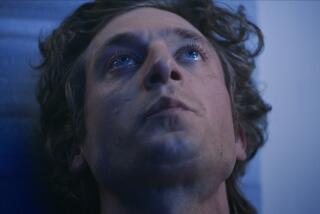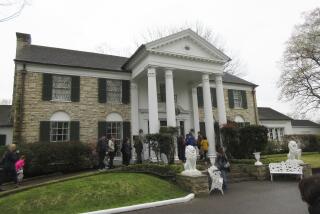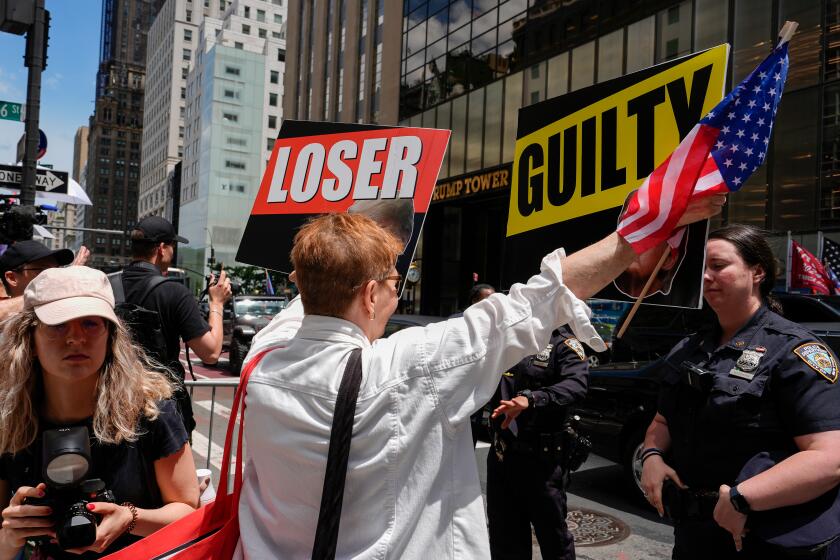The patron of their arts
IN the Santa Monica Canyon home she shared for more than 45 years with Lee Mullican, Luchita Hurtado, widowed since 1998, busies herself in the kitchen brewing coffee. Her youngest son, writer and filmmaker John Mullican, stands in the doorway, showing a hint of tension.
Windows offer a view of treetops, lashings of green against a gray Sunday sky. Visible in the distance is the dull metal sheen of the Pacific Ocean.
“My treehouse,” Hurtado tells a guest.
Nearly 85 and looking nowhere near it, the Venezuelan-born matriarch is still striking, with hazel eyes under strong brows, smooth olive skin and silvering black hair in a sleek coil. The guest, somewhat breathless, has hiked up the hillside to the wood-shingled house by way of 70 or more steps, a climb Hurtado makes regularly, unaided.
The visit is occasioned by an invitation to view a film in progress by John: a documentary about Lee Mullican, husband and father, respected professor of art at UCLA and a landmark yet sometimes overlooked figure in the history of midcentury American modern art.
John, 43, who shares his mother’s good looks and his father’s height, calls the film “Finding Lee Mullican,” a work he conceived not only as a tribute and creative endeavor, but also for personal reasons: He began the project after losing many of his friends to AIDS.
“I was so lost,” he says, and his father, then in his 70s, was “so in tune with life and the process of life.” John filmed interviews with his father and others over a two-year period, before the diabetic Lee’s death from liver failure at age 79. The film, then too painful to continue, was shelved, to be revived only last year.
A few weeks from this day’s home screening, the documentary’s final chapter, “a culmination and celebration,” will be filmed at the Los Angeles County Museum of Art, where “Lee Mullican: An Abundant Harvest of Sun,” the first major retrospective of the artist’s work, will continue through Feb. 20. John’s completed work, self-financed, will be screened at LACMA’s Bing Theater on Feb. 2 and again in New York when the exhibition opens at New York University’s Grey Art Gallery in April. “Then on to film festivals,” he says.
But just now the younger Mullican is anxious. His mother, with whom he shares an obviously warm connection, hasn’t seen the work.
And there is a slight delay. John’s partner, John Squatritto, is on his way from their home in West Hollywood with the DVD and a laptop computer on which to screen it.
Hurtado offers coffee and a bowl of Chinese jujubes to pass the time.
A style is born
AS it turns out, the story of Lee Mullican, a small-town Oklahoman who leapfrogged away from a religious, conservative background to embrace art and the cultural bohemia of the West Coast in the 1940s and ‘50s, is very much a family story. And a love story.
Besides John and brother Matt Mullican, 54, the New York-based artist, there is Daniel del Solar, 65, Hurtado’s son from her first marriage. She was with her second husband, Austrian-born Surrealist Wolfgang Paalen, when he, Lee and transplanted British painter Gordon Onslow-Ford formed their Dynatons group in the Bay Area after World War II.
It was the launch of what Times art critic Christopher Knight has called “Surrealism for the New World,” where all was perceived as possible in an aesthetic of cosmic freedom.
The artists’ union culminated in the groundbreaking “Dynaton” exhibition at the San Francisco Museum of Art in 1951. By that time, the Paalens’ marriage had ended, and Lee and Hurtado were an item. Matt was born that year, just before they relocated to this house in the canyon. The couple married later.
With the Dynatons as his springboard, Lee explored the possibilities of his own metaphysical and abstract terra incognita.
By all accounts, everything he absorbed broadened his artistic vocabulary: his work as a topographical draftsman in the Army Corps of Engineers during World War II, Cubism, Surrealism, jazz, the poetry of Gertrude Stein, foreign films, primitive and tribal art, Tantric art of India, Zen Buddhism, and the skies, land and sun of the Southwest.
“There’s an intimacy to this work, a meditative quality,” says Carol S. Eliel, the curator of the LACMA show. “People think of midcentury work as heroic, grandiose, sort of loud on a certain level. This is very different.”
In addition to its fantastic sense of color, the reason Lee’s work holds up, says L.A.-based artist John Baldessari, may be a pre-lingual quality that “somehow gets through to your brain. And that’s what good art should do.” The work, he adds, is “still enigmatic. It still poses questions.”
That Lee Mullican is not better known, Eliel says, can be attributed to his decision to head West rather than to New York, at a time when being in California “meant that you were by definition an eccentric.”
Few artists of that generation who lived and worked outside New York were able to penetrate the mainstream, she says.
“Gradually, over time, some of the wonderful artists who worked outside of New York have begun to be recognized. John McLaughlin comes to mind, and Ed Kienholz, who was a slightly younger generation. Hopefully now this will be Lee’s turn.”
Matt Mullican, whose own work is on view in “Ecstasy: In and About Altered States” at the Geffen Contemporary, says by telephone from New York that the LACMA show is a significant gesture of recognition, one long deserved.
His father’s work, Matt says, was never about fitting into the social schema of contemporary art. “It was about investigating what he felt to be the frontier of ... human experience, in a way. He, as many artists of that generation, really felt he was exploring new worlds. That was where he got his biggest rush.”
Having a show in a fancy gallery or museum “would have been wonderful, and he would have been so pleased, but what drove him was his work.”
Art and artifacts
A glance around Hurtado’s well-lived-in living room finds an eclectic clutter of books, family photographs, carvings, rugs, wall hangings and masks from the Mullicans’ frequent travels. A photograph of Lee, taken shortly before his death, shows a proud patriarch surrounded by family, including Matt’s then-toddler twins.
On the wall above an enormous bowl of fruit is a painting, a dense pattern of raised vertical lines in deep blue, red, green and yellow, done in Lee’s signature palette-knife style.
Beneath it is another painting: strong bare feet and drifting feathers on cracked ground. This is Hurtado’s work. At one time she had some gallery showings, but she hasn’t painted for ages. Losing Lee was “like losing a limb,” she says, and it left her without the peace of mind painting requires.
The DVD arrives, and John sets up the computer in a small den, the room where Lee died.
“Oh my God, oh my God,” Hurtado gasps, as footage of the wreckage of a World Airways plane, partially submerged in Boston Harbor, shows on the flat computer screen.
It is the 1982 crash of a flight that John, then 19, was on, flying alone from L.A. to Boston while his parents were in India. Two people died.
Hurtado reaches for John, seeking the contact.
“Just watch the movie,” he says, taking her hand. “Talk afterward.”
“Oh my God,” Hurtado says again, “I can’t believe it.”
The film shifts to media reports of Lee’s death, and then to Lee, grown heavier with age, a thatch of white hair falling over his forehead. John is heard asking him what he thinks about his son’s desire to make the film.
“I don’t know where it’s going to go,” Lee replies, “but wherever it goes, I’m sure it will be right.”
Hurtado wipes away tears.
The unfinished film shifts about in time: Lee working in his studio, laying paint on canvas with brush and knife; Lee clowning for the camera at home in his garden; Lee and John visiting his hometown, Chickasha, Okla.
“Memory is everything,” Lee says, as they go through abstract works from his college days. “I did it all on my own,” he says. “I wouldn’t even show these things because I knew they’d laugh at them. It was a great time of regionalism ... good artists, but it was nothing that interested me.”
In another segment, Lee and Hurtado sit together, taking John’s questions about their love affair and its effect on the Dynatons and on Paalen, who moved to Mexico and married again, then committed suicide in 1959.
And then, after a few segments more, the film abruptly ends.
“That’s as far as I got,” John says.
“Fantastic, it’s really wonderful,” his mother assures him.
Memories rekindled
WHEN Lee died, Hurtado says after a moment, “it was here in this room.”
“I remember,” she says to John, “you getting into bed and holding him.”
“The irony is that I knew so much about death,” John says. “When you’re dying and you no longer can say what it is you want, you still know touch.”
He wanted his father to know “that it’s OK to leave and go on to
“Whatever awaits you,” Hurtado finishes.
Watching the film was difficult for Hurtado:
“I miss him so much. I’ve grown to deal with it. However, there are those moments of surprise that you can’t protect yourself from.”
Yet she is able to laugh too.
“Oh, you have to. That’s what life is about. And that’s the best of life. You can’t have one without the other.”
Back in the living room, she adds, “Lee never lost that curiosity that children have, you know. I feel that way too. I see friends who don’t respond much anymore to the world, and you have to. It keeps the world new.”
The house is quiet now; it’s time for the guest to leave. But Hurtado has one more thing to say. After the furor of the LACMA exhibition dies down, she offers casually, “I’ll be ready to paint again.”
John is clearly moved. He hasn’t heard this before.
“To me,” he says later, “this LACMA show is healing this family on many levels, both personally and professionally. There is life after death, there is artistic creation after dormancy. My mother wants to paint again. I’m finishing this documentary....”
*
‘Lee Mullican: An Abundant Harvest of Sun’
Where: Los Angeles County Museum of Art, 5905 Wilshire Blvd., L.A.
When: Noon to 8 p.m. Mondays, Tuesdays and Thursdays; noon to
9 p.m. Fridays; 11 a.m. to 8 p.m. Saturdays and Sundays
Ends: Feb. 20
Price: $5 to $9
Contact: (323) 857-6000, www.lacma.org
More to Read
The biggest entertainment stories
Get our big stories about Hollywood, film, television, music, arts, culture and more right in your inbox as soon as they publish.
You may occasionally receive promotional content from the Los Angeles Times.






